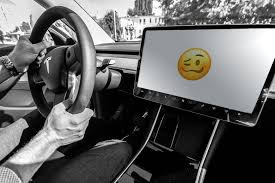Did you ever wonder why it’s OK to look at the touchscreen in your car, but it will cost you a driving violation if you hold your phone to text or call? A touchscreen, after all, is common to the phone, and increasingly, modern cars.
For safety’s sake there’s been a concerted effort to rein in how drivers use their phones in cars. But there’s been no analogous effort to manage how drivers interact with vehicle touchscreens. In fact, each year seems to bring fewer physical buttons and knobs on the car’s dashboard but larger screens. To understand why this presents a safety problem consider the lowly seat belt.
Since we buckle and unbuckle the seat belts in cars all the time why does the FAA insist that flight attendants continue to demonstrate the seat belt functions each time a plane takes off? Significantly, the logic hasn’t made its way into the mindset of the NHTSA (the federal agency that develops standards for both airplane and auto safety ).
“Lift to Release”
The demonstration to “insert the buckle” and “lift it to release” continues for two important reasons. First, the plane’s seatbelt mechanism works slightly differently. In a panicked emergency, passengers are prone to reach to the right or left of their thighs, as they do in an automobile. They search for a seat belt release button instead of lifting a flap.
Fliers are often disoriented or just plain tired. They may have gotten up too early, slept too little or too much during the flight, and passed the time with relaxants or a shot of alcohol. Whatever their state of awareness, the reminder to “lift the flap” is meant to build their “muscle memory.” The intention is that during a panicked moment muscle memory will kick- in.
Fortunately, airline disasters are rare but it’s said that even pilots are known to practice muscle memory in the cockpit, touching levers and buttons before takeoff. In an emergency they will remember where the controls are located and be able to act more quickly.
Of Deadly Importance
While it seems like a rare occurrence, the need for this training and repetition are of deadly importance. And it bears equal consideration for the UI (user interface) in today’s cars.
When drivers take the helm of a car there’s no attempt to build their “muscle memory”. That could be a significant factor accounting for the nearly 43,000 traffic deaths last year plus additional losses in injuries, property damage, and emergency response time.
There are attempts to rein in the distraction of smartphones in cars, but less attention to the touchscreens that divert a driver’s focus.
Don’t Push My Buttons
New touchscreens, often larger than an iPad, are becoming an industry standard in cars. Each manufacturer places screen controls in different spots. Most of the screen controls replace buttons. The touchscreen handles very basic things a driver must have, like control the manual operation of lights, defroster, windshield wipers, and more. Some mechanisms, like the wiper speed, require going two or three levels deep within the touchscreen menus. New 2024 Tesla Model 3 cars go further, and place the selection of gears (P-R-N-D) on the touchscreen, requiring the right level of haptic gesture and then a slide.
So, while drivers fumble to get their car in gear, It’s an irony that holding or manipulating a mobile phone while driving is illegal in most states, we sanction using the giant screen in our cars.
Touchscreens are here to stay because they are less expensive for automakers than traditional buttons and knobs. Manufacturers argue that they enhance a car’s performance with over-the-air updates. However, this advantage also presents a problem. Tesla owners complain after software updates that the text size on the screen changes and/or the icons are no longer in expected places. Put differently, swipes and taps no longer bring the expected response. Drivers have lost their “muscle memory.”
We don’t know how many more traffic accidents occur because a driver, facing a collision, takes their eyes off the road to fumble with the screen, or worse, activates the wrong controls. Harking back to why airplanes require seat belt training, drivers make mistakes after having a drink or two, swallowing a pill, or feeling the drowsiness of a long distance trip.
It’s Everywhere on the Road
The lack of “muscle memory” is not confined to experienced drivers who operate a familiar vehicle. Brand new drivers try out different cars after they take their driving test, people go to rental counters and select a model they have no experience with, and fleet drivers frequently switch from one vehicle type to another. Drivers from other countries operate right-handed steering wheels. Without some training none of these drivers acquire the “muscle memory” they need.
To overcome this deficit, UI experts often anticipate that for the future voice commands can substitute and do the heavy lifting. The spoken word could augment touchscreens and help overcome the irregular placement of controls. But the reality is that advanced voice commands will fail too. They depend on an exact syntax, specific words that the software recognizes. Voice commands also have difficulty interpreting regional accents and there is no single, global dictionary for international drivers.
If cars and trucks were designed like airplanes there would be a short training video and a mock assessment each time a driver put their foot on the accelerator. That repetition, over and over, would build the muscle memory. Without it, touchscreens are surely at the root of more traffic accidents than we acknowledge. In San Francisco, and soon other cities, the driverless, autonomous car diminishes the need for both physical buttons and this muscle memory. But, unless you are a passenger in these cars, it’s a good idea to think differently. Anticipate that the ‘other’ driver you see in the flashiest, state-of-the art vehicle also has the shortest “muscle memory.”

